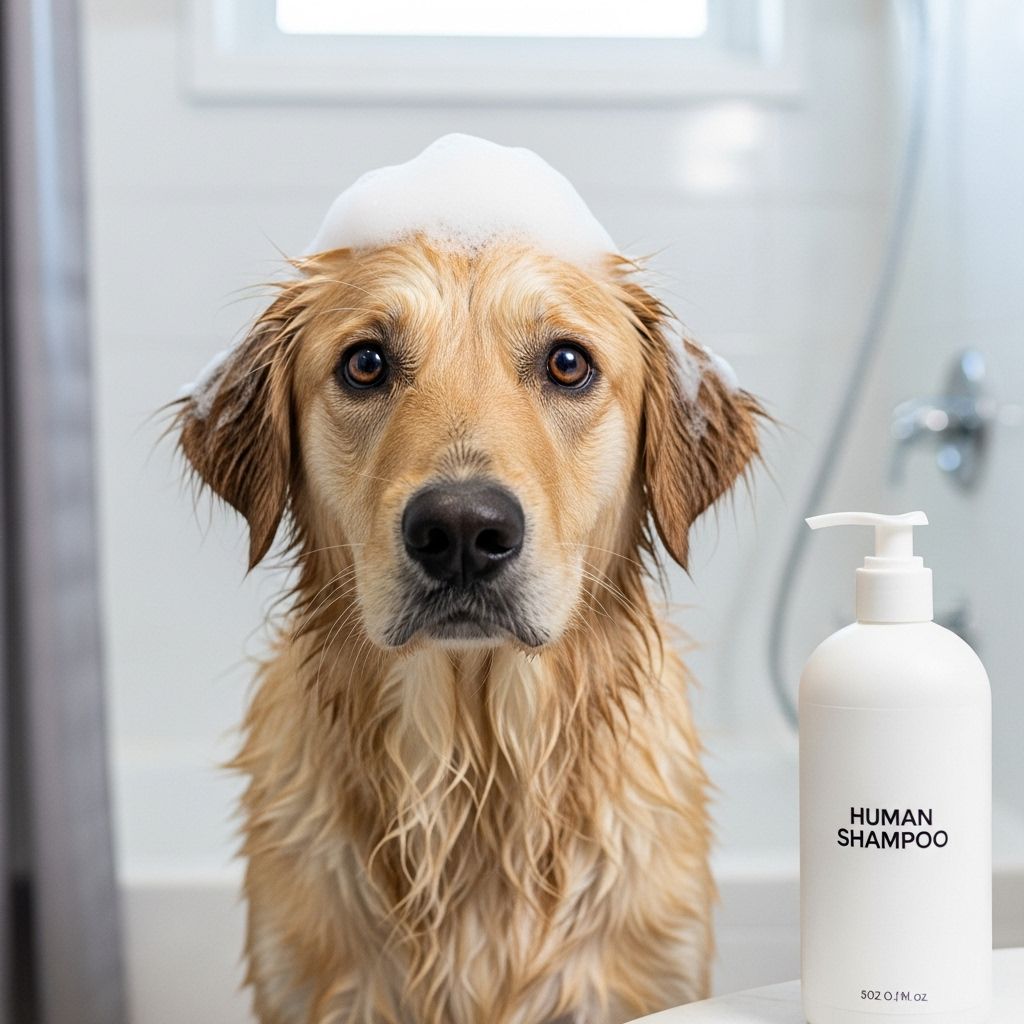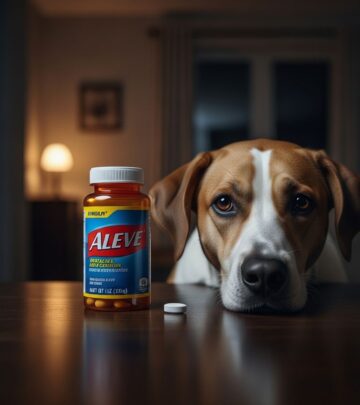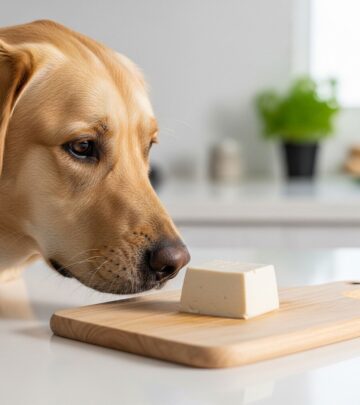Use Human Shampoo On Dogs: 6 Risks & Safe Alternatives
Discover why human shampoos are unsafe for dogs and learn the best practices for canine bathing and skin care.

Image: HearthJunction Design Team
Can You Use Human Shampoo on Dogs?
Bathing our canine companions is an essential aspect of pet care, helping them stay clean, fresh, and healthy. However, as dog owners, the question often arises: Is it safe to use human shampoo on dogs? While reaching for a bottle of human shampoo may seem convenient, understanding the science behind canine skin and the consequences of improper products is crucial for your pet’s well-being.
Why Bathing is Important for Dogs
Regular baths remove dirt, debris, and allergens from your dog’s skin and coat. Baths also prevent matting, reduce odors, and can be a valuable bonding experience between you and your pet. However, the products you use during these baths matter just as much as the bath itself, especially considering the physiological differences between human and canine skin.
What is the Acid Mantle, and Why Does it Matter?
The acid mantle is a thin, protective layer that covers the outer surface of the skin. Composed of oils, fatty acids, and sweat, this layer acts as a barrier against bacteria, viruses, and environmental contaminants.
- The acid mantle keeps skin hydrated by reducing water loss through evaporation.
- It is essential for maintaining a healthy microbiome—beneficial bacteria that protect against harmful pathogens.
When the acid mantle is disrupted—such as by using inappropriate shampoos—the skin becomes vulnerable. This increases the risk of infection, irritation, dryness, and other skin issues.
Differences Between Human and Dog Skin
Human and canine skin differ in several important ways, making products formulated for one species unsuitable for the other.
- pH Balance: Human skin is more acidic, with a pH of about 5.5 to 5.6, while canine skin ranges from a more neutral 6.2 to 7.4. Dog shampoos are designed to match this higher pH to preserve the acid mantle.
- Thickness and Sensitivity: Dog skin is thinner and more sensitive than human skin, making it more vulnerable to harsh chemicals and detergents found in human shampoos.
- Oil Production: Dogs have different natural oil compositions, requiring products that clean without stripping too much oil.
Risks of Using Human Shampoo on Dogs
Though it may be tempting to use your own shampoo for a quick clean-up, doing so can lead to numerous problems for your pet:
- Disrupted Skin Barrier: Human shampoo disrupts the dog’s acid mantle, stripping away protective oils and leaving the skin exposed to harmful bacteria, viruses, and parasites.
- Skin Irritation and Dryness: The imbalance caused by human shampoo can result in flakiness, itching, redness, and inflammation.
- Infection Susceptibility: Compromised skin can become a breeding ground for yeast and bacterial infections.
- Allergic Reactions: Many human shampoos contain fragrances, dyes, preservatives, sulfates, and parabens that can trigger allergies—causing rashes, hives, or even swelling and respiratory issues in dogs.
- Hard to Rinse: Human shampoo formulas may be more difficult to rinse out completely from a dog’s dense fur, leading to further irritation if residue remains.
- Eye Damage: Most human shampoos are not tear-free and can cause severe eye irritation or even injury if they get in your dog’s eyes.
What Happens If You Use Human Shampoo on Dogs?
Even a single bath with human shampoo can disrupt your dog’s skin barrier and cause mild to moderate irritation. Repeated exposure compounds the effects and can result in chronic problems such as:
- Persistent scratching and overgrooming
- Development of hot spots
- Ongoing skin infections
- Loss of fur and dull, brittle coats
Though a one-time emergency wash in a pinch is unlikely to cause severe harm, it is never recommended as a regular bathing method. Always prioritize products specifically formulated for dogs to avoid preventable discomfort and health issues.
The Science of Skin pH Balance
Proper skin pH is crucial for both humans and dogs, but the optimal levels differ. Human shampoos are formulated for the more acidic environment of human skin, while canine shampoos cater to their more neutral needs.
| Species | Typical Skin pH |
|---|---|
| Humans | 5.5 – 5.6 (acidic) |
| Dogs | 6.2 – 7.4 (neutral to slightly alkaline) |
Disrupting this natural balance makes the skin less effective at repelling microbes and maintaining moisture, increasing susceptibility to health problems.
Why Dog Shampoos Are the Safer Choice
Dog shampoos are crafted to match the unique chemical and physiological needs of canine skin. Using them provides several benefits:
- Protects the acid mantle and natural oils
- Reduces the risk of skin irritation and allergic reactions
- Promotes healthier, shinier coats
- Often includes ingredients for specific needs: moisture, deodorizing, flea and tick prevention, etc.
What To Do In a Pinch: Safe Alternatives
If you find yourself out of dog shampoo and your pet desperately needs a bath, consider these safer alternatives (for infrequent, one-time use only):
- Dawn Dish Soap: The original formula, when properly diluted, is sometimes used in veterinary emergencies to remove severe grease or toxins. It can be drying, so use sparingly.
- Baby Shampoo: Brands formulated for infants, such as Johnson’s Baby Shampoo or Burt’s Bees Baby Shampoo, are gentler and typically free from harsh chemicals. Still, these should not be a regular substitute for dog shampoo.
After any emergency wash with these alternatives, monitor your dog’s skin for signs of irritation and return to proper dog shampoo as soon as possible.
Choosing the Right Dog Shampoo
With many options available, selecting the appropriate dog shampoo can be overwhelming. Consider the following when making your choice:
- Skin Type: Is your dog’s skin normal, dry, or sensitive?
- Coat Type: Is your dog long-haired, short-haired, double-coated, or hairless?
- Special Needs: Does your dog have allergies, flea problems, or medical skin conditions?
- Ingredient Quality: Choose mild, hypoallergenic formulas free from artificial fragrances, colors, parabens, and sulfates whenever possible.
If your dog experiences persistent or severe skin issues, consult your veterinarian, who may recommend a medicated shampoo for conditions like seborrhea, mange, or allergies.
Bathing Best Practices for Dogs
To ensure a safe and comfortable bathing experience for your dog, follow these steps and tips:
- Brush your dog before the bath to remove tangles, mats, and debris.
- Use lukewarm water—hot water can further dry or irritate skin.
- Start with an appropriate dog shampoo, lather gently, and avoid eyes and inside the ears.
- Rinse thoroughly to prevent any soap or shampoo residue, which can cause itching or rashes.
- Dry your dog with a towel or on low heat with a pet-safe dryer.
- Reward your dog for good behavior during and after the bath to create a positive association.
Frequently Asked Questions
Q: What happens if I use human shampoo on my dog once?
A single use may cause mild skin irritation, dryness, or itching. Prolonged or repeated use increases the risk of chronic skin issues and infections.
Q: Are natural or organic human shampoos safer for dogs?
Even “natural” or organic human shampoos are formulated for human skin pH and may contain essential oils or botanical extracts that irritate or are toxic to dogs. It’s best to use shampoos specifically designed for dogs.
Q: Is baby shampoo safe for dogs?
Baby shampoos are gentler and less likely to cause irritation but should only be used rarely and not as a substitute for dog shampoo. Always monitor your dog for any adverse reactions after use.
Q: How often should I bathe my dog?
Bathing frequency depends on breed, coat type, and activity level. Most dogs benefit from a bath every 4–8 weeks, but dogs with oily skin or those prone to dirt may need more frequent baths. Overbathing can strip natural oils, so avoid excessive washing.
Q: What ingredients should I avoid in dog shampoo?
Avoid products with artificial fragrances, colors, sulfates, parabens, and harsh chemicals. Look for formulas marked as hypoallergenic and consult your veterinarian for recommendations suited to your dog’s needs.
Conclusion: Keeping Your Dog Safe and Clean
While the temptation to use human shampoo on your dog may arise, especially in a pinch, the risks far outweigh the convenience. Protect your pet’s delicate skin and overall health by choosing shampoos designed specifically for dogs. A small investment in the right grooming products can prevent discomfort, health issues, and expensive vet visits down the line, ensuring your dog stays happy, healthy, and clean.
References
- https://www.akc.org/expert-advice/health/human-shampoo-on-dogs/
- https://www.petmd.com/dog/general-health/can-you-use-human-shampoos-on-dogs
- https://www.purina.com/articles/dog/health/routine-care/can-you-use-human-shampoo-on-dogs
- https://www.groomers-online.com/blog/2024/03/can-i-use-human-shampoo-on-my-dog/
- https://st-argo.com/blogs/our-advice/experts-guide-the-proper-way-to-wash-your-dog
Read full bio of medha deb












